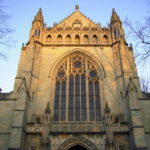What is Stanford University Known For?
What is Stanford known for? Stanford has developed a reputation as one of the country’s great institutions of higher education, consistently ranking in the top ten best colleges in the country. In addition to outstanding academics, Stanford is known for its great return on investment and entrepreneurial student body. Here are some other unique aspects of this top school. Location: Stanford, California Undergraduate Enrollment: 7,904 Acceptance Rate: 4% Middle 50% SAT: 1510-1570 Middle 50% ACT: 34-35 Stanford is a cross between MIT and Harvard in that it values students with both technical aptitude and strong leadership. The school prioritizes STEM, but values students with diverse academic interests—this is reflected in the admissions process, in which Stanford places a higher weight on the several short essays found in its supplement. What is Stanford University known for? First and foremost is its academics. Year after year, Stanford ranks among the most difficult colleges to get into, which has cultivated a campus populated with accomplished professors, brilliant students, and an achievement-focused attitude. Stanford is made up of seven academic schools: Of those seven schools, only three offer undergraduate programs: the Stanford Doerr School of Sustainability, the School of Engineering, and the School of Humanities & Sciences. In fact, roughly 75% of all undergraduate degrees are awarded by the School of Humanities & Sciences. Despite Stanford’s renown as a feeder for Silicon Valley, the school offers more than 65 majors, covering everything from Aeronautics and Astronautics to Urban Studies. Stanford’s best-known undergraduate school is its School of Engineering, which ranks third on our list of best engineering schools. The engineering program has nine academic departments: Interdisciplinary study is extremely important at Stanford, and the university has numerous ways for students in different fields to collaborate. The School of Engineering’s Hasso Plattner Institute of Design (also known as “the d.school”) brings students and faculty from all fields together to share different perspectives and push the design process. Similarly, the Stanford Doerr School of Sustainability’s Stanford Woods Institute for the Environment serves as a hub for the university’s interdisciplinary environment and sustainability research—a place where students and staff tackle the environmental challenges of today and tomorrow. Speaking of sustainability, Stanford has been powered by clean and renewable energy since 2022. Stanford’s Engineering Program doesn’t just push collaboration on campus; it prepares its students for participation in an ever-shrinking world. The university’s Global Engineering Programs (GEPs) provide students with the opportunity to learn about technology and engineering on a global scale, while gaining real-world experience and building professional networks in an international setting. No matter what discipline you study at Stanford, you’ll encounter an amazing community of scholars, including: Academics might steal the spotlight at Stanford, but the university’s athletics have a storied history and remain an important part of campus life. Stanford-affiliated athletes have won 296 Olympic medals since 1912 and have earned a medal in every Olympics in which the U.S. has competed since then. Stanford sports have achieved glory beyond the Olympics as well—Stanford varsity teams have won 173national championships (including 137 NCAA titles) and, for 49 consecutive years, a Stanford team has claimed a national championship, the longest streak in the nation. Famous Stanford athletes include: There are numerous other opportunities for Stanford students, both off the field and out of the classroom. The Ram’s Head Theatrical Society is the university’s oldest and largest theatrical society, dating back to 1911. More than 100 members strong, Ram’s Head provides participants opportunities in acting, directing, designing, and playwriting. The group’s productions are attended by more than 6,000 people annually. The Stanford Mendicants are another well-known group on campus, particularly for their trademark red blazers. The Mendicants are the university’s original a cappella group, formed in 1963. Members of the Mendicants are frequently seen serenading students everywhere from the stage to the school’s stairwells. [amp-cta id="9459"] Full Moon on the Quad (FMOTQ) is one of Stanford’s longest-running traditions—it began in the early 1900s when freshmen women would meet during the first full moon of the year and receive their first kiss ever from a male senior. Over the years, the tradition has evolved from sharing a kiss to exchanging white roses to hugs to meeting new people. This experience continues to grow to reflect cultural changes and shifting attitudes. Stanford’s mascot is also the subject of a unique tradition—the Cardinals, the name of the school’s sports teams, refers to the color, not the bird, and the school has never settled on an official mascot. With no official mascot, the band decided on a tree. Every year, the band’s tree costume is redesigned by the student who wears it. What is Stanford known for? It’s hard not to mention “the Big Game” when someone asks the question—you can tell an event is important when it takes possession of such a ubiquitous name. The Big Game dates back to 1892 when Stanford first squared off against its rival, UC Berkeley (Cal), in football. The game is held at Stanford in odd-numbered years and at Cal in even-numbered years. The rivalry is intense and seeps into every aspect of campus life between the two schools. Stanford has one of the largest campuses in the country—it’s a staggering 8,180 acres and is home to more than 26,000 trees, 1,000 species of plants, and 25 fountains. A testament to the fantastic weather and the college’s commitment to sustainability, students will find over 16,000 bicycle parking spots on Stanford’s campus. Walk through the gates to Stanford’s main campus and take in the view of the university’s red-clay-tiled-roofed buildings and the iconic Memorial Church. Stanford practices need-blind admissions, which means admissions decisions are made without considering an applicant’s ability to pay. Stanford is committed to meeting the full demonstrated need of its students. About two-thirds of Stanford students receive some form of financial aid—including athletic scholarships—and nearly half receive need-based scholarships. Students from families earning less than $150,000 (with assets typical of that income level) pay no tuition, while students from families earning less than $100,000 (with assets typical of that income level) pay no tuition, room, or board. Stanford provides financial aid in the form of scholarships, which do not require repayment. Stanford is one of the top-spending colleges in the country when it comes to research. In 2023-2024, the school sponsored 7,500 external projects with a total budgeted expenditure of $1.98 billion. Stanford is home to a handful of specialized research centers, such as: Stanford’s proximity to Silicon Valley (just 40ish miles away on the other side of the bay), home to some of the world’s most renowned tech companies, makes the school a popular destination for students pursuing careers in tech. Numerous Stanford alumni have made names for themselves and amassed impressive futures across the bay, including: In the 2024-2025 admissions cycle, Stanford received more than 57,000 applications. Highly selective schools like Stanford use a tool called the Academic Index—a distillation of a student’s entire academic profile into a single numerical representation—to cull the applicant pool and weed out candidates who don’t meet the university’s high academic standards. If your academics fail to meet Stanford’s standards, it’s likely that an admissions officer will not give your application a serious look. One way to understand your odds at Stanford (and at hundreds of other colleges across the U.S.) is with CollegeVine’s free chancing engine. Our chancing engine uses quantitative metrics such as GPA and test scores, along with more qualitative aspects like extracurricular activities, to predict your odds of admission. In addition, our chancing calculator provides valuable insight into your college profile and offers tips on how to improve it. What’s Covered:
Overview of Stanford Admissions
Unique Aspects of Stanford
Academics
Extracurriculars

Traditions
Campus
Financial Aid
Resources
Location
What Are Your Chances of Acceptance at Stanford?




